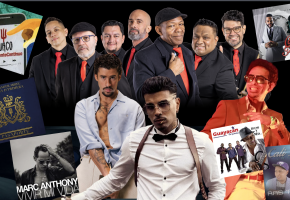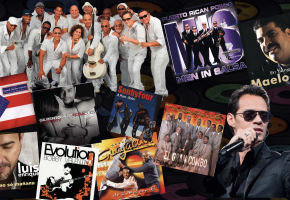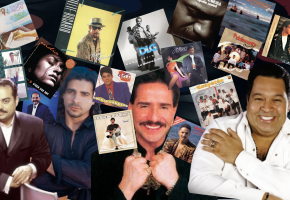1. Graciela
During the first wave of latin music in the USA, what was called the Mambo Kings era, Graciela was the most prominent female artist of the time. Sister of mambo legend Frank “Machito” Grillo (one of the Mambo Kings) and married to Mario Bauza, one of the most influential Cuban musicians ever to live, she was one of the lead singers in Machito and his Afrocubans, the band that popularized mambo and pioneered latin jazz. Born in Havana, Cuba, in 1915, Graciela the very first black latina to gain fame in the US. Her ability to perform both romance-filled boleros or upbeat guarachas saw her move to New York in 1943, following Machito’s military inscription, where she became known The First lady of Latin Jazz. After the war, the trio became headline act at the Palladium Ballroom and on the New York social scene. Her best known songs; ‘Esta es Graciela’, ‘Íntimo y Sentimental’ and ‘Esa Soy Yo, Yo Soy Así’ are timeless Salsa classics and still retain their magic to this day. Check out this explicit tune, the reggaeton of its day!
2. Celia Cruz
The ‘Reina de la Salsa’ was born in 1920’s Havana. An avid performer of santería and traditional yoruba songs, the singer spent her youth winning various musical competitions and was already lead singer for La Sonora Matancera, Cuba’s most popular band ever, when Fidel Castro assumed power in 1959. In the early 60s, the whole band left to tour in Mexico and never returned. From there Celia arrrived in the US, but it wasn’t until 1973 when Fania records, already the power house of Latin music industry, got her to sing in the Latin Opera “Hommy,” that her career took off. From then on Celia was the indisputed “Queen of Salsa” until her death in 2003. While salsa’s popularity seemed to peak in the late 70s, there was no downturn in Celia Cruz’s fortunes when the 80s arrived. That decade not only witnessed Cruz reuniting with La Sonora Matancera for an album, it also found her making an entry in The Guinness Book Of World Records for a free outdoor concert in Tenerife – at that time the biggest event of its kind, attracting 250,000 people. Recalling the concert in her autobiography, she wrote: “An event like that goes to show the importance of exporting the music of my tiny homeland throughout the world.” But this footage below taken from the Fania Zaire concert 1974 shows Celia's pure charisma, for she could even make this boring song exciting!
3. Yolanda Rivera
The lead singer on some of the greatest hits of La Sonora Ponceña (Puerto Rico’s finest Salsa band), such as Ahora Si and Madrugada, Yolanda is one of the most recognizable voices in Salsa. Born in Puerto Rico, she fell in love with Cuban music at an early age. After stints with some of NY finests bands , it was with “La Terrífica” orchestra that Yolanda came to her own. It was after this that she returned to Puerto rico and joined La Poncena, one of Salsa most emblematic bands. She is still active today.
4. Celina Gonzalez
Like Celia, Gonzalez was one of Cuba’s leading female vocalists and songwriters. Celia even recorded Celina's songs. Unlike Celia, Celina decide whether to stay in Cuba to support Fidel Castro’s revolution, which thwarted her international career but boosted her standing at home with regular appearances on radio. In the 80s she recorded four albums at the celebrated Egrem studios in Havana, on which she was backed by two of Cuba’s finest country bands, Palmas y Canas and Campo Alegre. When González finally ventured out of Cuba in the 80s for the first time in many years, she found she had not been forgotten. Playing at a musical festival in Cali, Colombia, in 1984, she won the award for best singer and was greeted by a crowd of 40,000 who knew all her songs. She also enjoyed success in Venezuela, and toured all over Europe. She never achieved the degree of international success enjoyed by her compatriot Omara Portuondo of the Buena Vista Social Club, but made several successful British appearances. In 1998 she performed at the Royal Festival Hall, and in the same year released Desde La Habana Te Traigo (I Bring You from Havana), which included new songs about Yoruba deities. She was nominated for a Grammy in 2001 for her album Cincuenta Años … Como una Reina (Fifty Years As a Queen), was awarded the Cuban National Music prize in 2002, and in 2013 received the Unesco Picasso medal.
5. La Lupe
The ‘Queen of Latin Soul’ was born in 1939 in Santiago, Cuba. Daughter of a Bacardi distillery worker, La Lupe shot to national fame in 1954 after winning a competition on national radio. It was whilst singing at Havana’s famed ‘La Red’ nightclub that this amazon with an incredible voice and empassioned onstage antics caught the attention of famous foreigners including Ernest Heminway, Marlon Brando and Jean-Paul Sartre. Her first álbum ‘Con el Diablo en el cuerpo’ was released in 1960. After a move to the US in 1962, and partnering with the acclaimed Tito Puente, her career took off with albums Tú y yo and The King swings, the incredible Lupe sings in 1965. Lupe was the first Latin Singer to have a sell-out performance at New York’s Madison Square Garden. Famed for her boleros, boogaloos and son montunos, the singer dedicated her last few years to her devout following of the santería religion. She died of a heart attack in 1992. Lupe’s fiesty, energetic performances and partnership with Tito make her a female Salsa legend.
6. Canelita Medina
Canelita is Venezuela’s most successful female salsa singer, considered to be one of the greatest symbols of the "Son Montuno" and one of the most versatile voices in Venezuela singing a wide variety of genres including Son, Guajira, Montuno and Bolero. She began in the 1950s with Federico Betancourt in "Federico y su Combo Latino" and was the only female in the orchestra. As solo artist Canelita recorded the legendary album Sones y Guajira, a classic of Venezuelan discography. She alternated solo concerts with guest performances for the likes of Orquesta América, La Aragón, Sonora Matancera, El Gran Combo de Puerto Rico, Los Hermanos Lebrón, Estrellas de Fania, Richy Ray and Bobby Cruz, Sonora Ponceña, Johnny Pacheco, Celia Cruz, Oscar D'León and José Mangual Jr. She performed solo all over Venezuela and the Latin Caribbean and attended many festivals as a special guest.Recently She was a special guest at the Oscar D'Leon concert held in the Aula Magna UCV, celebrating 50 years with the Orquesta Sinfónica Municipal de Caracas.
7. Choco Orta
Born in Santurce, Puerto Rico, Choco Orta is considered one of Puerto Rico’s finest ever salsa singers. She is also a super percussionist. In the noughties she stood out and gained admiration for the feeling she transmitted and smooth delivery that is quintessentially Puerto Rican. She soon began winning awards and sung as guest of honour at "National Salsa Day", where she had the audience in her pocket as she shared the stage with El Gran Combo in front of a crowd of more than 30,000 people. She has sung with all the big Puerto Rican and Cuban bands such as José Félix Gómez, Andy Montañez and Gunda Merced. Her big hit Basta still kills it on the dance floor, and is likely to be one of those tunes that lasts forever. All you have to do is listen to her to see how good she is...
8. Albita
Albita was groundbreaking as the first female salsa singer who didn’t conform to the overly-feminine stereotypes, when she exploded onto the scene in Miami in the nineties, in suit and tie and with short hair. She has been a successful singer in Cuba and was on tour in Colombia when she decided to defect. When she moved over to Miami, almost immediately, in 1994, she landed the opportunity to record with Emilio Estefan’s (husband of Gloria) record label, Crescent Moon and brought out her first USA single: “Qué Manera de Quererte”, (What a way of Loving You), followed by her album “No se Parece a Nada” (Like Nothing else). Her debut CD Albita Llegó that won her two Grammys in the category of Best Contemporary Tropical Album. She went on to have multiple Grammy and Emmy nominations and shared the stage with Celia Cruz, Willy Chirino, Phil Collins, Tony Bennett, Gilberto Gil, Juan Luis Guerra, Daniela Mercury, Miriam Makeba, Arturo Sandoval, Paquito D’Rivera and Melissa Etheridge.
9. La India
Linda Viera Caballero, aka ‘La princesa de la Salsa’, was born in 1985 in Puerto Rico, but moved to the Bronx soon after her birth. Her grandmother named her India because of her long dark hair and indigenous features. In the mid-nineties La India exploded onto the Salsa scene via an album with Eddie Palmieri and also the reléase of songs produced by then husband Litle Louie Vega. She went on to have a huge hit with Marc Anthony 'Vivir lo Nuestro' which proved her to be the salsa powerhouse that JLo could only drwm of. that onNot your traditional Salsa singer, she is also well-known on the House scene, for her powerful vocals, and has thus managed to stay relevant throughout the decades.
10. Haila Mompié
Haila Mompié is currently one of the world’s best soneras of her generation. Beginning with the group Septeto Tradition in 1991, she wowed audiences with her voice and charisma and embarked on her first international tour with the show “Guajira Habanera Show” with the Habana Son group. She joined Bamboleo in 1994, touring Italy, Holland, England, the United States, Belgium, France, Peru and Mexico. In 2001 Haila began her solo career and has since shared the stage with renowned national and international singers such as Cheo Feliciano, Oscar de León, Celia Cruz, Gilberto Santa Rosa, Chucho Valdés, Issac Delgado, David Calzado and Adalberto Álvarez. She was nominated for the Latin Grammy with her album La rumba soy yo. In this production, the renowned singer shows her beautiful tone and great versatility.
And we couldn't go without mentioning...
Gloria Estefan
Although Gloria is best known as a pop icon of the nineties, she has never stopped championing salsa music and her album 'Mi Tierra' was the best selling salsa album before the big hitters like Marc Anthony came along. Mi Tierra featured some of the best latin and salsa musicians of the day, such as Tito Puente, Luis Enrique, Arturo Sandoval, Cachao López, Chamin Correa and Paquito D'Rivera.You could even say that she laid the groundwork for the global commercial success of salsa, for the album even charted at no.36 in the UK charts and until a few years ago was the 6th best selling Latin album in the US.



















